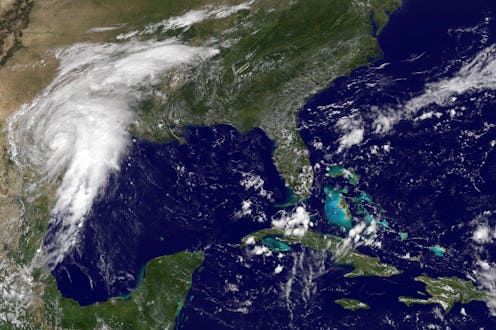News
How Hurricane Hermine Got Its Name
There's a hurricane headed toward the Gulf Coast, but the potential floods and destructive winds are not the focus of news reports. It's actually the storm's name, Hermine, that is noteworthy. For one, it's rather close to Hermione, the beloved character from Harry Potter. And two, there's a whole band of Twitter users who are upset that the storm wasn't named Harambe for the gorilla killed at the zoo in Cincinnati when a four year old fell into his cage this May. So why is it called Hurricane Hermine?
Its name was actually selected far in advance. There is a list for each year that is selected by an international committee at the United Nations World Meteorological Organization. They take submissions in several languages — names have been in French, Spanish, English, and Dutch, for example — for both the Atlantic and Pacific Oceans, and then they repeat the lists every seven years. The lists don't overlap; the name is either on the Atlantic list or Pacific list. Then, only if a storm becomes particularly violent or destructive do they retire the name and replace it. There now is a long list of retired storm names dating back to 1954.
At the beginning of the hurricane season the first one gets a name that starts with the letter "A," then the names move through the alphabet. Already this year there have been Atlantic storms named Alex, Bonnie, Colin, Danielle, Earl, Fiona, and Gaston. After Hermine will come Ian, Julia, and Karl, onwards to Walter, interestingly skipping the letter "Q." Nor are there names that begin with "X," "Y," or "Z." If there's more storms than names in one year, they move on to other names that begin with letters from the Greek alphabet.
The first named storms were in the Caribbean and named after the saint's day that they fell on. Then after a long break, the first modern named storm was in 1953. At that point it was still the National Hurricane Center (NHC) that named them. The reason for the change was that short, recognizable names — those that are "quicker and less subject to error" — were easier to use in communication with the public. For example if there are two storms happening at once, the public doesn't confuse the two. Before geographic names were used with latitude and longitude for reference. This is "especially important in exchanging detailed storm information between hundreds of widely scattered stations, coastal bases, and ships at sea," according to the NHC.
Interestingly, only women's names were used for about 25 years. Men's names were added in 1978 to Pacific storms and in 1979 to Atlantic storms. As for those wanting a storm named Harambe or Hermione, they will have to wait at least until 2022 — and only if Hermine is retired. The upcoming "H" names are Harvey, Helene, Humberto, Hanna, and Henri.
